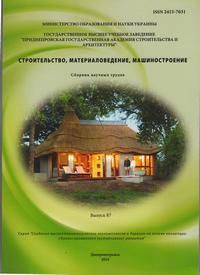Select orientation of buildings c zell optimization teploэnerhetycheskoho influence on external climate of the building thermal balance for example backyard Poltava
Keywords:
green building, thermal balance, planning, wind regime.Abstract
Purpose. Explore product optimization of buildings with heat and power to determine the impact of external climate on the heat balance of the building on the example of the city of Poltava. Method. empirical research methods were used to achieve the purpose of the study, including the observation, comparison, measurement, by the exampleof a more detailed study of the issue of optimal spatial orientation buildings - multi-storey residential building in the city of Poltava. Results. The study wind conditions, and other factors that affect the space-planning solution of the building, it was concluded that the best orientation is the latitude. It identifies a number of advantages over the latitudinal orientation of the meridian. So in winter the greatest amount of heat from direct solar radiation enters the wall south orientation of buildings, in the summer the greatest amount of heat from a cut solar radiation enters a day on the walls of the east and west orientation, the room with windows oriented to the south have a favorable insolation in summer and fall in winter low, deep penetrating rays in space, given the prevalence ofthe heating season winds east and west directions, latitudinal orientation is optimal. The necessity to pay more attention to space-planning decisions of buildings to maximize energy efficiency in construction. Scientific novelty and practical meaningfulness. Currently Ukraine energy resources over time in increasing its cost, resulting in a need to build a fully autonomous nonvolatile construction. It is soon to become an important and a priority of this for any construction company or organization.
References
Green Building [electronic resource]: [website]. - Electronic data. - Access: www.ecolabel.org.ua.
Sustainable development [electronic resource]: [website]. - Electronic data. - Access: uk.wikipedia.org.
7 projects vыdayuschyhsya Norman Foster [electronic resource]: [website]. - Electronic data. - Access: zvt.abok.ru.
Geography Poltava [electronic resource]: [website]. - Electronic data. - Access: geo.pnpu.edu.ua/climate.php.
Climate and weather Poltava [electronic resource]: [website]. - Electronic data. - Access: www.studfiles.ru.
Ukrayinsyky hidrometsentr [electronic resource]: [website]. - Electronic data. - Access: meteo.gov.ua.
Climate Poltava [electronic resource]: [website]. - Electronic data. - Access: ru.climate-data.org.
Tabunschykov, the building of power effective A. [Text] / A. Tabunschykov, MN Brodach, NV Shilkina. - M. Avoca + Press, 2003. - 200 p.
Noyfert, PA Design and construction [Text] / P. Noyfert, L. Neff. - Moscow: Architecture + C, 2007. - 235 p.
Downloads
Published
Issue
Section
License
Редакція Видання категорично засуджує прояви плагіату в статтях та вживає всіх можливих заходів для його недопущення. Плагіат розглядається як форма порушення авторських прав і наукової етики.
При виявлені у статті більш ніж 25% запозиченого тексту без відповідних посилань та використання лапок, стаття кваліфікується як така, що містить плагіат. У цьому випадку стаття більше не розглядається редакцією, а автор отримує перше попередження.
Автори, в статтях яких повторно виявлено плагіат, не зможуть публікуватися в усіх журналах Видавництва ДВНЗ «Придніпровська державна академія будівництва та архітектури».
Автори, які публікуються у цьому журналі, погоджуються з наступними умовами:
- Автори залишають за собою право на авторство своєї роботи та передають журналу право першої публікації цієї роботи на умовах ліцензії Creative Commons Attribution License, котра дозволяє іншим особам вільно розповсюджувати опубліковану роботу з обов'язковим посиланням на авторів оригінальної роботи та першу публікацію роботи у цьому журналі.
- Автори мають право укладати самостійні додаткові угоди щодо неексклюзивного розповсюдження роботи у тому вигляді, в якому вона була опублікована цим журналом (наприклад, розміщувати роботу в електронному сховищі установи або публікувати у складі монографії), за умови збереження посилання на першу публікацію роботи у цьому журналі.
- Політика журналу дозволяє і заохочує розміщення авторами в мережі Інтернет (наприклад, у сховищах установ або на особистих веб-сайтах) рукопису роботи, як до подання цього рукопису до редакції, так і під час його редакційного опрацювання, оскільки це сприяє виникненню продуктивної наукової дискусії та позитивно позначається на оперативності та динаміці цитування опублікованої роботи (див. The Effect of Open Access).

